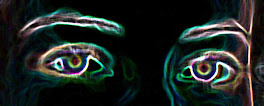Dr. Diana George's article on the depiction of poverty definitely diagnosed the problem clearly and accurately; basically, non-profits that use those images rely too heavily on the images' ability to be readily understood. In fact, the generalizations made for the sake of time usually hinders the goal for which the pictures were intended. The issue to far too complex to be encapsulated in the stereotypes that have served us thus far.
I get that. It makes sense that something as complex as poverty cannot be represented in copy-cat hyperbole mimicking the devastation of the 1930s. However, I failed to grasp Dr. George's answer to the problem. Perhaps the paper only sought to diagnose the issue. Perhaps I misread it under the pressure of "onto the next homework assignment." But in any case, I failed to capture a solution to the problem that she presented.
As I ponder any possible solutions of my own, I am struck with a new thought: Are images really the best way to present as intricate a problem as poverty to begin with? Do we really have to bow to the all-powerful IMAGE in this new Informational Age?
Photography used to be lauded as the objective eye-witness. But as its use and study progresses, it becomes increasingly obvious that even a camera is subjective. Even more subjective: the interpretations of its products. Maybe, then, it is better to use a medium that inherently forces reflection--such as text. When you are reading these words I am writing, you are forced to interact with them--to both absorb and interpret them in a specific order, specific time-frame and under specific guidelines (generally called grammar). Photographs can be treated the same way but they lend themselves to the kind of instantaneous comprehension that usually satisfies viewers, not launches them into further contemplation.
In summary:
*What was Dr. George's solution?
*Do our modern communication practices exclude the possibility of text-based interaction?
*If we cannot avoid the image, how do we break down these stereotypes--visual re-writes?
skip to main |
skip to sidebar

This blog celebrates the wonderful cross-pollination across academic disciplines that contributes to the formation of Reisytal the Human Being.
--peering--
